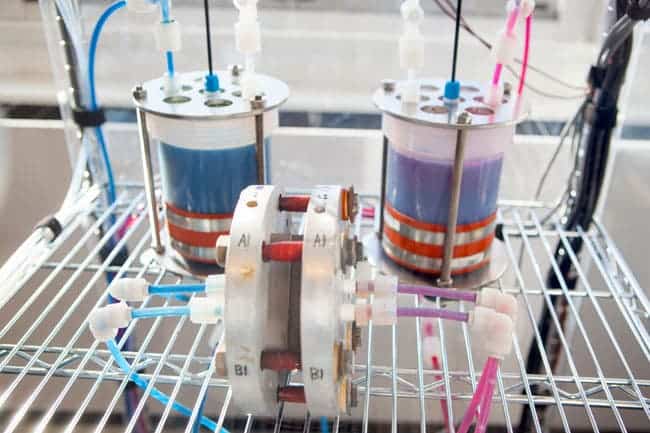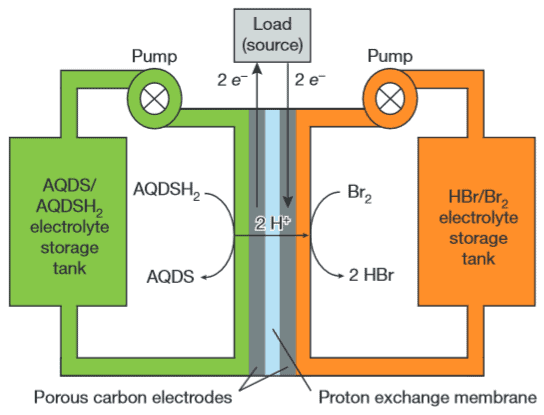One of the biggest arguments against renewable energy deployment on the truly massive scale is their unreliability. Justly so, wind doesn’t always blow at desired velocities and the sun fluctuates in sunshine throughout the day. With this in mind, if you don’t have a back-up storage medium, intermittent renewables will always be an alternative – second place to fossil power plants that can ensure base load. A new energy storage proposal from Harvard researchers may help provide a solution. The researchers report their work on an organic flow battery made up of readily available chemicals and metals, making-up for a cost-effective solution to an extremely demanding problem.
Base load renewable energy
Your car and mobile phone’s battery is made up of solid-electrode batteries. While they certainly do the trick, the fact that both power conversion and energy capacity hardware are stored in the same unit makes these types of batteries unsuited for large scale applications. If you wanted, for instance, to store 50 hours worth of energy from a 1-megawatt wind turbine you’d need to buy a traditional battery rated for 50 megawatt-hour of energy storage, only it’d come with a 50 megawatt power capacity. It’s a huge waste of hardware, one that would make the stored electricity significantly more expensive than your fossil-based grid electricity.
A flow battery is very similar in construction to a fuel cell – an electrochemical cell where a dissolved electrolyte solution reversibly converts electrical energy – with the key distinction that the ionic solution is stored outside of the cell, and can be fed into the cell to generate electricity. This is of great interest to engineers since it solves the combined power capacity issue in traditional batteries.
[ALSO READ] New fuel cell design might spark micro-grid revolution
Until now, flow batteries relied on chemicals that are expensive and difficult to maintain, like vanadium, or/and rare, noble metal electrocatalysts like platinum. Researchers at the Harvard School of Engineering and Applied Sciences recently demonstrated a flow battery that uses alternative chemicals. Their battery works on organic (carbon-based) molecules called quinones, which are similar to molecules that store energy in plants and animals.
An organic battery for a greener future
Quinones are abundant in crude oil as well as in green plants, and as an added safety measure these can be dissolved in water to prevent fires. For solar or wind installations to become reliable, some 48 hours worth of storage would ensure baseload. The researchers envision their flow battery being fed from storage tanks located in the basement of wind turbines. Alternatively, larger tanks can be used to accommodate points where multiple turbines and solar panels are used.
At the consumer level, there’s no reason the same technology, at a smaller scale, can’t be applied. Instead of a back-up gas burner, a home could have a flow battery installed which stores the extra energy from solar panels installed on the roof. It would provide enough energy to keep the house running throughout the night and even late morning.
More tests are needed, however, before anything sure can be said about the reliability of the Harvard researchers’ flow batteries. So far, the batteries have been demonstrated for 100 cycles. A practical application would require thousands of cycles, though, and before thorough benchmarks are made, any assumptions or hype should be kept to a minimum.
“You could theoretically put this on any node on the grid,” said f Michael J. Aziz, one of the researchers involved in the paper. “If the market price fluctuates enough, you could put a storage device there and buy electricity to store it when the price is low and then sell it back when the price is high. In addition, you might be able to avoid the permitting and gas supply problems of having to build a gas-fired power plant just to meet the occasional needs of a growing peak demand.”
“The intermittent renewables storage problem is the biggest barrier to getting most of our power from the sun and the wind,” Aziz said. “A safe and economical flow battery could play a huge role in our transition off fossil fuels to renewable electricity. I’m excited that we have a good shot at it.”
The findings were reported in a paper published in the journal Nature.











